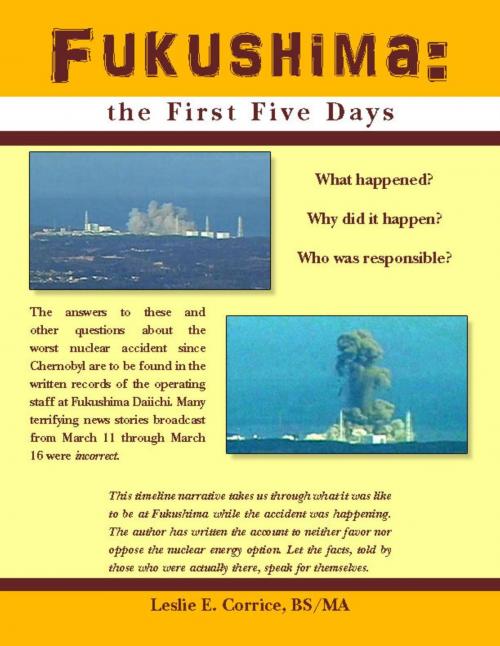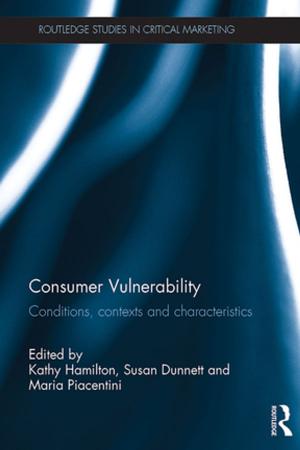| Author: | Mr. Leslie E. Corrice | ISBN: | 9780985769901 |
| Publisher: | The Hiroshima Syndrome | Publication: | April 8, 2012 |
| Imprint: | Language: | English |
| Author: | Mr. Leslie E. Corrice |
| ISBN: | 9780985769901 |
| Publisher: | The Hiroshima Syndrome |
| Publication: | April 8, 2012 |
| Imprint: | |
| Language: | English |
For five days beginning March 11, 2011, the Fukushima Daiichi Nuclear Power Station in Japan experienced the worst nuclear accident since Chernobyl in 1986. Why was the accident possible? What happened during these crucial five days? Who might have been responsible? A combination of government complacency, industrial arrogance, and an economic conflict of interest are unquestionably involved. International recommendations for greatly improved tsunami protections, beginning in the 1990s, were repeatedly rejected by the Japanese regulators and Tokyo Electric Power Company as being too expensive and based on events too unlikely to be considered. They were very, very wrong. The main body of the book follows the sequence of actions performed by the operators at Fukushima Daiichi, between March 11 and March 15, 2011. The accident scenario itself is taken from the control room’s timelines and converted into narrative. The five-day account provides explanations of operator terminology and the relevant emergency systems mentioned in the control room records, literally translating them into everyday language and using simple graphics whenever possible. These records strongly indicate that despite inadequate tsunami protection, and a complete electrical blackout (alternating current), all meltdowns and hydrogen explosions could have been averted. The critical event was the meltdown and hydrogen explosion of unit #1, which literally doomed the reactor fuel cells of units 2 and 3 to their respective fates. It also made the hydrogen explosions of units 3 and 4 virtually inevitable. The unit #1 meltdown and hydrogen explosion could have been avoided if it were not for poor emergency power preparations, a lack of extreme emergency procedures, a feeling of disbelief on the part of the staff that something terrible was happening, and political interference that reduced any sense of immediacy with respect to on-site actions. The text further addresses numerous incorrect news media reports broadcast during and soon after the first five days at Fukushima, including; a spent fuel pool fire in unit #4 (it was an electrical fire two floors below the pool), fears of seawater causing the fuel cells to begin re-fissioning (which is impossible), and rumors of the massive earthquake causing the meltdowns (control room records show there was neither structural damage nor any emergency system malfunction due to the quake). The text also challenges two official Japanese reports concerning three aspects of the accident, and provides plausible alternatives. First, the Japanese government and Tokyo Electric Power Company (TEPCO) insist that unit #2 experienced a full meltdown, similar to units #1 and #3. However, the control-room records indicate that the unit #2 fuel cell may not have been “dry” and uncooled long enough for a full, core-relocating meltdown to have happened. Second, the Japanese government and Press maintain there was a hydrogen explosion inside the containment structure of unit #2 on March 15. I explain the myriad of technical problems with this judgment. Grossly inadequate tsunami protection at Fukushima Daiichi Nuclear Power Station triggered a very serious nuclear accident, with public impacts which promise to extend far into the future. The narrative reveals what happened at Fukushima while the accident occurred, from the viewpoint of the plant’s staff. Whether or not one favors or disfavors the nuclear energy option, ultimate judgment on the issue should include an unbiased understanding of what happened, and what did not happen during Fukushima's first five days. The account neither favors nor opposes the nuclear energy option. Let the facts, told by those who were actually there, speak for them-selves.
For five days beginning March 11, 2011, the Fukushima Daiichi Nuclear Power Station in Japan experienced the worst nuclear accident since Chernobyl in 1986. Why was the accident possible? What happened during these crucial five days? Who might have been responsible? A combination of government complacency, industrial arrogance, and an economic conflict of interest are unquestionably involved. International recommendations for greatly improved tsunami protections, beginning in the 1990s, were repeatedly rejected by the Japanese regulators and Tokyo Electric Power Company as being too expensive and based on events too unlikely to be considered. They were very, very wrong. The main body of the book follows the sequence of actions performed by the operators at Fukushima Daiichi, between March 11 and March 15, 2011. The accident scenario itself is taken from the control room’s timelines and converted into narrative. The five-day account provides explanations of operator terminology and the relevant emergency systems mentioned in the control room records, literally translating them into everyday language and using simple graphics whenever possible. These records strongly indicate that despite inadequate tsunami protection, and a complete electrical blackout (alternating current), all meltdowns and hydrogen explosions could have been averted. The critical event was the meltdown and hydrogen explosion of unit #1, which literally doomed the reactor fuel cells of units 2 and 3 to their respective fates. It also made the hydrogen explosions of units 3 and 4 virtually inevitable. The unit #1 meltdown and hydrogen explosion could have been avoided if it were not for poor emergency power preparations, a lack of extreme emergency procedures, a feeling of disbelief on the part of the staff that something terrible was happening, and political interference that reduced any sense of immediacy with respect to on-site actions. The text further addresses numerous incorrect news media reports broadcast during and soon after the first five days at Fukushima, including; a spent fuel pool fire in unit #4 (it was an electrical fire two floors below the pool), fears of seawater causing the fuel cells to begin re-fissioning (which is impossible), and rumors of the massive earthquake causing the meltdowns (control room records show there was neither structural damage nor any emergency system malfunction due to the quake). The text also challenges two official Japanese reports concerning three aspects of the accident, and provides plausible alternatives. First, the Japanese government and Tokyo Electric Power Company (TEPCO) insist that unit #2 experienced a full meltdown, similar to units #1 and #3. However, the control-room records indicate that the unit #2 fuel cell may not have been “dry” and uncooled long enough for a full, core-relocating meltdown to have happened. Second, the Japanese government and Press maintain there was a hydrogen explosion inside the containment structure of unit #2 on March 15. I explain the myriad of technical problems with this judgment. Grossly inadequate tsunami protection at Fukushima Daiichi Nuclear Power Station triggered a very serious nuclear accident, with public impacts which promise to extend far into the future. The narrative reveals what happened at Fukushima while the accident occurred, from the viewpoint of the plant’s staff. Whether or not one favors or disfavors the nuclear energy option, ultimate judgment on the issue should include an unbiased understanding of what happened, and what did not happen during Fukushima's first five days. The account neither favors nor opposes the nuclear energy option. Let the facts, told by those who were actually there, speak for them-selves.















